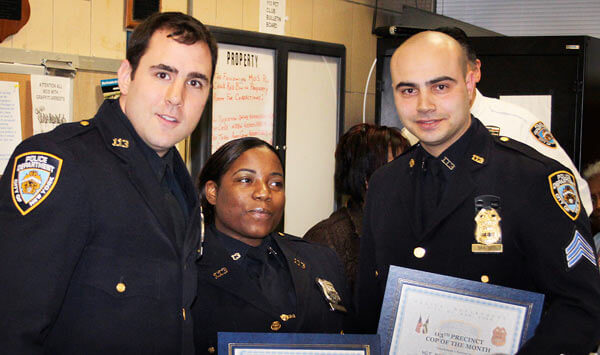By Rich Bockmann
As gang violence in southeast Queens grows, a member of the NYPD’s gang division visited the 113th Precinct Monday evening to educate the precinct’s community council on how to identify gang members.
Detective Rafael Ramos said the two most prevalent gangs in the area are the Bloods and the Crips, and there are particular signifiers they use to identify themselves.
The Bloods, he said, wear red and “flag” to the right, meaning they wear a bandana in their right pocket or a doo-rag to the right side. The Crips wear blue and flag to the left, but Ramos warned that any one single identifier cannot be used alone to spot gang members.
“You can’t take one thing. You have to be able to see the whole picture,” he said, explaining that some younger people may wear red or blue as their school’s color.
“In California, if you wear the wrong color in the wrong neighborhood, you’re asking for trouble. It’s starting to get like that here,” he said.
Deputy Inspector Miltiadis Marmara, the 113th’s commanding officer, said shootings in the precinct have been on the rise, logged in at 11 vs. eight the same time last year.
He attributed the increase to a particular sect of the Bloods and said the 113th, along with the 103rd and 105th precincts, had made some recent arrests he hoped would curtail the violence. The 103rd Precinct covers Jamaica while the 105th Precinct stretches from Glen Oaks down along the Nassau County border through Queens Village, Rosedale and Springfield Gardens.
Ramos said gang members often defy stereotypes. He said he once witnessed a 6-year-old Jewish boy holding bullets for members of a Mexican gang and pointed out there are many girls in gangs. The detective said he had arrested gang members as young as 13 and said parents should beware if they see their children watching videos that gang members post online.
“The Internet is how they communicate with each other,” he said, advising parents to place computers in places where children can be supervised. “The Internet is how they get new guys in the gang.”
Gang graffiti, he said, can be spotted on walls throughout the neighborhood and can also be found in the notebooks of younger members.
He said the Bloods like to draw a “B” with an arrow sign pointing up and a “C” with one pointing down, for “Bloods up, Crips down.” Bloods draw five-pointed stars and Crips draw six-pointed ones, he said, explaining Crips will use terms like “Six poppin’, five droppin’” and “Code Blue” when speaking about committing acts of violence against their rivals.
He said individual gangs have their own policies on members leaving: Some require a member to be beaten out, others allow members to leave freely.
Marmara said anyone who suspects a friend or a family member of being in a gang can contact Community Affairs Officers Dorrin Ferguson and Tanya Duhaney at 718-712-1627 or Youth Officers Angel Ramos and Jermaine Washington at 718-712-7894.
Reach reporter Rich Bockmann by e-mail at rbockmann@cnglocal.com or by phone at 718-260-4574.




































